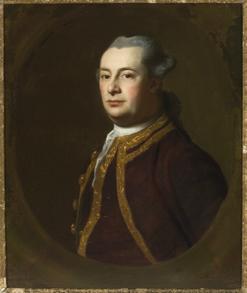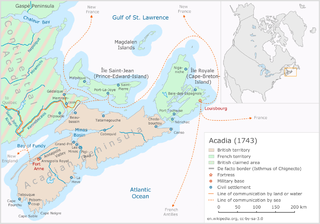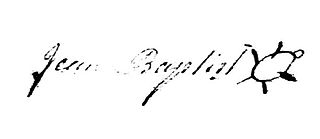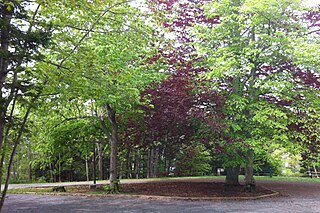
The Mi'kmaq are a First Nations people of the Northeastern Woodlands, indigenous to the areas of Canada's Atlantic Provinces, primarily Nova Scotia, New Brunswick, and Newfoundland, and the Gaspé Peninsula of Quebec as well as Native Americans in the northeastern region of Maine. The traditional national territory of the Mi'kmaq is named Miꞌkmaꞌki.

Michael Francklin or Franklin served as Nova Scotia's Lieutenant Governor from 1766 to 1772. He is buried in the crypt of St. Paul's Church (Halifax).
The Eskasoni Mi'kmaw Nation is a band government of the Mi'kmaq First Nations, located in Unama'ki, Nova Scotia, Canada. As of 2021, Eskasoni has a membership of 4,675. Of this population, 3,973 live on-Reserve, and 667 live off-Reserve.
Shubenacadie is a village located in Hants County, in central Nova Scotia, Canada. As of 2021, the population was 411.

St. Marys Bay south western Nova Scotia, Canada, is surrounded by the modern municipal districts of Clare Municipal District and Digby.
Indian Brook 14 is a Mi'kmaq reserve located in Hants County, Nova Scotia. In the 2016 Census, the reserve has 1,089 residents.

Abbé Jean-Louis Le Loutre was a Catholic priest and missionary for the Paris Foreign Missions Society. Le Loutre became the leader of the French forces and the Acadian and Mi'kmaq militias during King George's War and Father Le Loutre's War in the eighteenth-century struggle for power between the French, Acadians, and Miꞌkmaq against the British over Acadia.

Abbé Pierre Antoine Simon Maillard was a French-born priest. He is noted for his contributions to the creation of a creation of a writing system for the Mi'kmaq people of Île Royale, New France. He is also credited with helping negotiate a peace treaty between the British and the Mi'kmaq that resulted in the Burying the Hatchet ceremony. He was the first Catholic priest in Halifax, Nova Scotia, and is buried in the St. Peter's Cemetery, in Downtown Halifax.

Father Le Loutre's War (1749–1755), also known as the Indian War, the Mi'kmaq War and the Anglo-Mi'kmaq War, took place between King George's War and the French and Indian War in Acadia and Nova Scotia. On one side of the conflict, the British and New England colonists were led by British officer Charles Lawrence and New England Ranger John Gorham. On the other side, Father Jean-Louis Le Loutre led the Mi'kmaq and the Acadia militia in guerrilla warfare against settlers and British forces. At the outbreak of the war there were an estimated 2500 Mi'kmaq and 12,000 Acadians in the region.

Jean Baptiste Cope was also known as Major Cope, a title he was probably given from the French military, the highest rank given to Mi’kmaq. Cope was the sakamaw (chief) of the Mi'kmaq people of Shubenacadie, Nova Scotia. He maintained close ties with the Acadians along the Bay of Fundy, speaking French and being Catholic. During Father Le Loutre’s War, Cope participated in both military efforts to resist the British and also efforts to create peace with the British. During the French and Indian War he was at Miramichi, New Brunswick, where he is presumed to have died during the war. Cope is perhaps best known for signing the Treaty of 1752 with the British, which was upheld in the Supreme Court of Canada in 1985 and is celebrated every year along with other treaties on Treaty Day.

The attack at Mocodome was a battle which occurred during Father Le Loutre's War in present-day Country Harbour, Nova Scotia on February 21, 1753 which saw two British mariners and six Mi'kmaq killed. The battle ended any hope for the survival of the Treaty of 1752 signed by Governor Peregrine Hopson and Mi'kmaq chief Jean-Baptiste Cope.
Daniel Nicholas Paul,, was a Canadian Miꞌkmaq elder, author, columnist, and human rights activist. Paul was perhaps best known as the author of the book We Were Not the Savages. Paul asserts that this book is the first such history ever written by a First Nations citizen. The book is seen as an important contribution to the North American Indian movement. One writer stated, "It's a Canadian version of Dee Brown's bestseller Bury My Heart at Wounded Knee and, as such, served a valuable purpose in raising public consciousness about Miꞌkmaq history, identity, and culture."

Louis-Pierre Thury was a French missionary who was sent to North America during the time of King William's War. He was a liaison between the French and their Native American allies during the course of the conflict, and died soon after it ended.
The Attack at Jeddore happened on May 19, 1753, off Jeddore, Nova Scotia, during Father Le Loutre's War. The Mi'kmaq killed nine of the British delegates and spared the life of the French-speaking translator Anthony Casteel, who wrote one of the few captivity narratives that exist from Acadia and Nova Scotia.

The military history of the Acadians consisted primarily of militias made up of Acadian settlers who participated in wars against the English in coordination with the Wabanaki Confederacy and French royal forces. A number of Acadians provided military intelligence, sanctuary, and logistical support to the various resistance movements against British rule in Acadia, while other Acadians remained neutral in the contest between the Franco–Wabanaki Confederacy forces and the British. The Acadian militias managed to maintain an effective resistance movement for more than 75 years and through six wars before their eventual demise. According to Acadian historian Maurice Basque, the story of Evangeline continues to influence historic accounts of the expulsion, emphasising Acadians who remained neutral and de-emphasising those who joined resistance movements. While Acadian militias were briefly active during the American Revolutionary War, the militias were dormant throughout the nineteenth century. After confederation, Acadians eventually joined the Canadian War efforts in World War I and World War II. The most well-known colonial leaders of these militias were Joseph Broussard and Joseph-Nicolas Gautier.

The Treaty of 1752 was a treaty signed between the Mi'kmaq people of Shubenacadie, Nova Scotia and the governor of Nova Scotia on 22 November 1752 during Father Le Loutre's War. The treaty was created by Edward Cornwallis and later signed by Jean-Baptiste Cope and Governor Peregrine Hopson. Cornwallis was at the signing at Cope's request.

St. Aspinquid's Chapel was established by Priest Louis-Pierre Thury at Chebucto in the late 17th century. The chapel is a natural stone amphitheatre located by Chain Rock Battery on the Northwest Arm at Point Pleasant Park. There are numerous notable people interred in the burial grounds around the chapel and it is also the location of the Mi’kmaq celebration of the Feast of St. Aspinquid, which was conducted through much of the 18th century. During the French and Indian War two Mi'kmaw chiefs fought each other in a battle near the chapel (1760).
Paul Laurent was a Chief of the La Have Mi’kmaq tribe. He was aligned with Father Le Loutre throughout Father Le Loutre’s War. The British killed his father when he was younger, which he tried to avenge by killing one of Jean-Baptiste Cope’s prisoners.

The Peace and Friendship Treaties were a series of written documents that Britain signed between 1725 and 1779 with various Mi’kmaq, Wolastoqiyik (Maliseet), Abenaki, Penobscot, and Passamaquoddy peoples living in parts of what are now the Maritimes and Gaspé region in Canada and the northeastern United States. Primarily negotiated to reaffirm the peace after periods of war and to facilitate trade, these treaties remain in effect to this day.
The 2020 Mi'kmaq lobster dispute is an ongoing lobster fishing dispute between Sipekne'katik First Nation members of the Mi'kmaq and non-Indigenous lobster fishers mainly in Digby County and Yarmouth County, Nova Scotia. The dispute relates to interpretations of R v Marshall, a 1999 Supreme Court of Canada ruling upholding the Halifax Treaties, empowering Indigenous Canadians the right to fish. Non-Indigenous fishers negatively reacted to off-season fishing activities of a self-regulated Indigenous lobster fishery, mainly citing concerns of potential overfishing.












